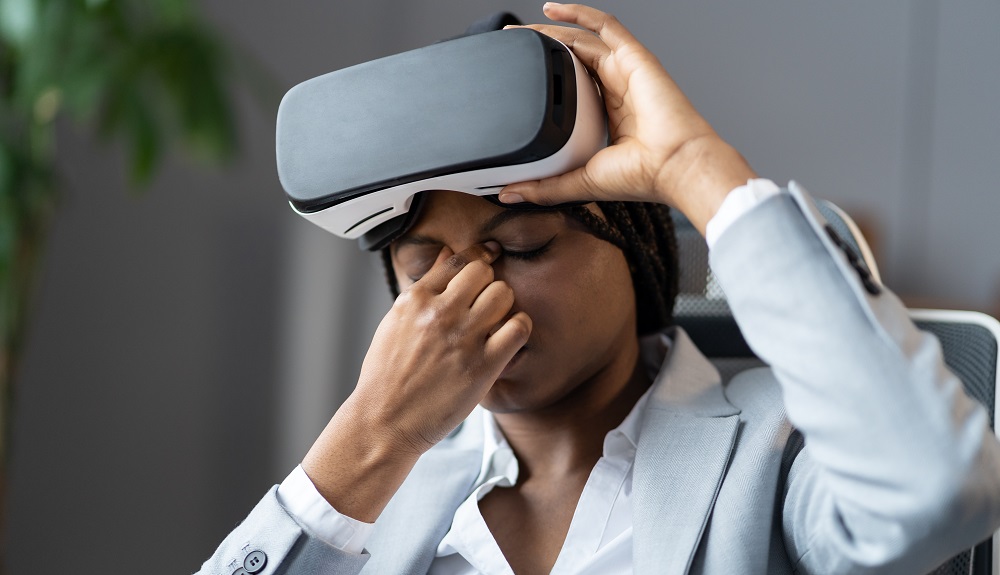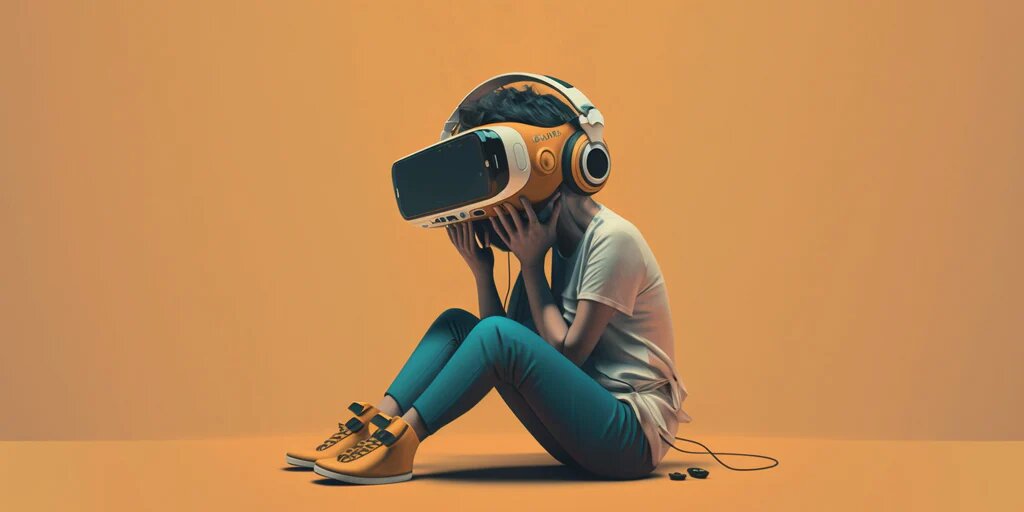Cybersickness in Virtual Learning: Enhancing VR Design for Student Well-being

Ever tried watching something or playing a game in VR? Ever felt sick after you took that headset for a spin? Well, you’re not the first to feel that way with your brush with VR. It’s definitely not uncommon.
In fact, the phenomenon is known as ‘Cybersickness’ – considering how it is similar to motion sickness, with people often experiencing either a headache, eye strain, disorientation or nausea.
As per a study that was published in the science journal Nature, somewhere between 22 to 80% of the people experiencing VR exhibited symptoms of cybersickness, with the indicators ranging from mild to moderate.
And this is a fairly common concern for participants using VR, regardless of the activity or process for which it is intended.
This was a source of concern for how VR was implemented and designed for video games for a long time, considering how it is through gaming that VR became massively popular.
In fact, even today, more than 50% of the VR market is largely dominated by VR applications and services for games and similar activities.
However, the medical condition and symptoms can similarly affect other cases where VR is being used for its advantages – such as healthcare training, visualizations and the overall education of young students.
It might not be as intense as witnessing high-paced virtual reality games, but the conditions may still arise, leading to students experiencing cybersickness symptoms while learning or practicing.
What is Cybersickness in VR and how can it impact students?

Cybersickness often manifests from using VR in some way or the other in people who are sensitive to its effects.
According to Barnett-Cowan, an associate professor of health sciences, situations in which people are able to adapt how they process sensory information are the least affected by this, with more symptoms manifesting in those who adapt much less.
But that’s what virtual reality sickness really is at its core: a sense of disconnect between the sensory information that a person’s body receives and what they see in the virtual reality headsets. This can be exacerbated by factors such as:
1. Individual Sensitivity:
In all the studies and observations made about the experiences of people using VR, some individuals tend to be more prone to experiencing motion sickness and being susceptible to cybersickness.
This would be the same for students with their cybersickness in VR experiences.
2. VR Design:
The content and the characteristics of VR design also play a significant role in this, such as having rapid transitions in the scene, head tracking latency, sudden movements, audio jitters, etc.
It can lead to some poorly optimized experiences for students, which would then contribute to the symptoms they might feel after using the headsets.
3. Duration Used:
Sometimes, all it takes for the symptoms to begin for users or students could stem from simply using the VR device for too long.
Long durations on the headset can increase the intensity of the effects over time and also affect how long does cybersickness in VR last.
In any person, the vestibular system is mainly responsible for maintaining a stable balance in the body and keeping spatial orientation.
Any one of the reasons mentioned above, or the general time a student or user may spend in a VR session, can cause this issue.
For instance, the visuals one sees might suggest a change in the viewing perspective or movement while they are stationary, confusing their brain and sensory inputs, etc.
Design Strategies to Combat Cybersickness in Virtual Learning
Implementing VR and virtual reality applications in an educational environment for students and kids has been a demonstrably empowering experience.
According to a report from The App Solutions, around 97% of students expressed a deep interest in taking a VR course for their studies.
The same report highlights how 70% of teachers recognize the benefits of VR technology and believe it can be an exciting and knowledgeable experience for their students, relevant to the courses they would be teaching.
With the market for Virtual Reality climbing ever higher (almost $33 billion as per The Business Research Co.), there’s a serious need for improving and making VR designs better in order to tackle cybersickness. Such as:
1. Optimizing FoV:
FoV, or field of view, can often be responsible for triggering cybersickness symptoms in users and students. Both excessive as well as limited could be equally bad, and VR developers can make it a priority to ensure that the FoV is set at a comfortable and realistic range.
This should let students feel immersed while viewing any educational course or content without having to experience a visual field that’s distorted and causes discomfort.
2. Depth Perception and Rendering:
Depth of perception can be affected by a range of graphical design choices and settings in a VR experience.
It could be affected by things like scaling if it isn’t proper, the lighting and shadowing in a scene, and the occlusion and depth of field settings, among others.
The developers should pay attention to their 3D rendering and design choices about these matters so that there are fewer visual discrepancies for students or anyone viewing their course.
3. Smoothing and Acceleration:
Jerky movements and sudden transitions can be a key moment in a VR experience for any user that throws their perception and causes cybersickness.
The design team can avoid this by providing smoother transitions for the user to experience and that their changes in camera perspective see more gradual levels of acceleration and deceleration.
This would be crucial for any user to maintain their sense of spatial orientation since the speed of their vision in virtual reality will be consistent and predictable.
4. Latency and Responsiveness:
Low latency and an increase in the overall responsiveness of any VR application can be a boon to users who are sensitive to lag and input slowdowns.
Developers could work on this to ensure that a user’s movements and the corresponding updates to their visual info are as quick as possible.
This would be important to maintain a comfortable VR experience for the user and see to it that their sense of presence is as good as possible without any bit of cybersickness creeping in.
5. Friendly UI:
Often overlooked, but an equally important part of the VR design process is the user interface that a user gets to experience. The menus, buttons, controls, on-screen info and display items should be designed with a user-friendly approach, especially for students and the content that’s being shipped.
This would allow the team to minimize the amount of cognitive load the user will experience and prevent any confusion from setting in.
One tip they could take in designing the user interface is that the interactive elements and UI items should be placed in a way that is visible comfortably to the user and doesn’t obstruct their peripheral vision.
Overall, these design considerations can significantly change the VR experience for students and allow developers or educational content creators to prioritize the well-being of students.
Any student opting for a virtual reality course will be able to avoid cybersickness in virtual learning as their experience will be well-tailored to maximize comfort and minimize other issues and symptoms.
This will be important for schools and institutes, even colleges and universities, to secure the well-being of their students as they opt to induct VR into their curriculum.
And most importantly, regular feedback from users and conducting user-based tests in the future will allow virtual reality-based firms to keep refining the design and address the chances of potential issues.




